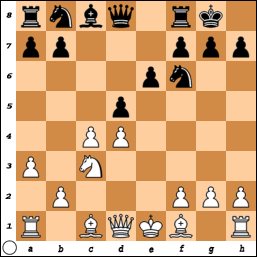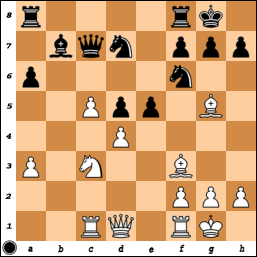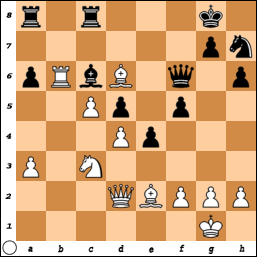First, a test position. Find the strongest continuation for White.

The solution can be found at move 24 of the game below.
Andrew Greet – Basil Laidlaw
Glasgow 2014
On encountering the Nimzo-Indian in this recent game, I decided to try out Lars Schandorff’s recommendation of 4.e3 followed by Ne2, even though I couldn’t remember too many of the fine details.
1.d4 Nf6 2.c4 e6 3.Nc3 Bb4 4.e3 0–0 5.Ne2 c5 6.a3 Bxc3+ 7.Nxc3 cxd4 8.exd4 d5

I spent a few minutes here, as I couldn’t remember any exact moves from this position, but I knew there was a similar variation where Black exchanged on c3 and played …d5xc4, leading to an IQP position. Then I realized I was thinking of the following line: 4…c5 5.Ne2 cxd4 6.exd4 d5 7.a3 Bxc3+ 8.Nxc3 Now I remembered: Black usually exchanges with 8…dxc4 here, allowing a convenient 9.Bxc4 in one move. “There must be a reason why Black normally exchanges on c4 in that position”, I thought. Instead 8…0–0 would transpose to the game position. This led me to deduce that the best move must be:
9.c5
After the game I checked Schandorff’s volume on the Indian defences, and found that he did not consider this variation. It’s understandable as the …dxc4 line is more popular, and I suppose most readers will be able to work out for themselves that White should play c4-c5 if given the opportunity. Still, it will be necessary to make some important decisions over the next few moves.
9…b6 10.b4 bxc5
10…a5 11.Rb1 does not really help Black.
11.bxc5
11.dxc5!? is an ambitious alternative. It may be good for White, but it is rather double-edged. Against a lower-rated opponent I was content with a more stable position in the centre.
11…a6?
Too slow. Black should prefer one of 11…e5, 11…Nc6 or 11…Ne4.
12.Be2 Qc7
I was expecting 12…Nc6 , as I thought my opponent’s idea was to develop the knight here without allowing Bb5.
13.0–0 e5 14.Bg5 Nbd7 15.Rc1 Bb7 16.Bf3

16…e4
When this move was played, I considered the position strategically winning. It wasn’t easy for Black though, as his centre was under pressure, and he had to worry about c5-c6 ideas as well as simple moves like Re1.
Exchanging does not solve Black’s problems either: 16…exd4 17.Qxd4 h6 (17…Qxc5?? 18.Bxf6 gxf6 19.Qg4+ picks up the knight on d7.) 18.Bxf6 Nxf6 19.c6! Bxc6 20.Nxd5 Nxd5 21.Bxd5 Rad8 22.Qc4 Rxd5 23.Qxd5 Qxh2+ 24.Kxh2 Bxd5 25.Rfd1 with a winning endgame.
17.Be2 Rfe8 18.Qd2 h6 19.Bf4 Qd8 20.Rb1 Bc6 21.Rb3
Not the only good move, but I liked having the rook on the third rank as it might swing to the kingside at some point.
21…Nh7 22.Rfb1 f5 23.Bd6 Qf6
We have reached the position shown in the initial diagram.
24.Rb6!
I considered 24.Rb7 but then noticed a more effective way of taking out the key defensive piece.
24…Nxb6 25.Rxb6 Rec8
25…Bb5 26.Nxd5 Qf7 27.Nc7 is crushing.
25…Rac8 26.Bxa6 White wins back the exchange and the a-pawn is already lacing up its running shoes.

26.Rxc6
A simple follow-up, leading to material gains.
26…Rxc6 27.Nxd5 Qg5
27…Rxd6 was a better try, but after 28.Nxf6+ Rxf6 29.d5 the pawns are too strong, especially with Black’s pieces so disorganized.
28.Ne7+ Kh8 29.Qxg5
After I played this I noticed the amusing possibility of 29.h4!? intending 29…Qxd2 30.Ng6+ Kg8 31.Bc4 mate! Black can avoid this with 29…Qf6, when 30.Nxc6 wins easily. Still, swapping the queens off was the easiest way to end the game.
29…Nxg5 30.Nxc6 Ne6 31.Bc4 Nf8 32.Ne5 Kh7 33.c6 f4 34.c7 e3 35.Kf1
1–0
Interesting game! I chose your first alternative on move 24, but the move you played indeed is even better.
Well played! Glad I managed to think of 24.Rb6. Luckily my mind did not wander away too much into 24.Rb7 🙂
Nice win Andrew
It was not too difficult to find 24.Rb6 BUT it was easier being a study like position where you are looking for something special. I could very easily have missed or at least not given it enough consideration if it was the middle of one of my own games.
It took 0.5 sec to find Rb6 :))
Your Computer is quite old, isn’t it? :)))
Very nice game. I especially liked the reasoning behind 9. c5
Thomas, without computer assistance :))